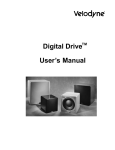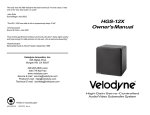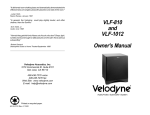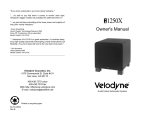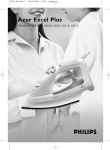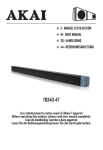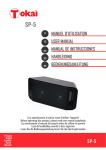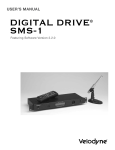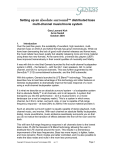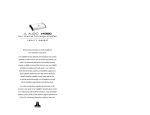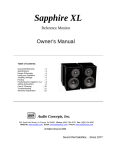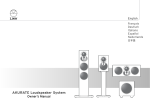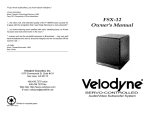Download Velodyne Acoustics HGS-15 THX User's Manual
Transcript
"If you know subwoofers, you know about Velodyne." -Corey Greenberg Home Theater Technology/February 1995 Face Off: Comparison of five subwoofers "In general, the Velodyne could play slightly louder, and often cleaner, than the Sunfire." -D.B. Keele, Jr. Audio/ June 1998 HGS-15 THX Ultra 2 and HGS-18 THX Ultra 2 Owner's Manual "How do they get this kind of bass out of such a tiny box? Deep, tight, tuneful and loud enough to rattle pictures on the wall--this is serious subwoofing." -Robert Deutsch Stereophile Guide to Home Theater/September 1998 ———————————————————————————————— Velodyne Acoustics, Inc. 345 Digital Drive Morgan Hill, CA 95037 408.465.2800 voice 408.779.9227 fax Web: www.velodyne.com Service E-mail: [email protected] Product E-mail: [email protected] Technical E-mail: [email protected] Printed on recycled paper. 10-02, #63-620 Rev. B High Gain Servo-Controlled Audio/Video Subwoofer System IMPORTANT SAFETY INSTRUCTIONS INSTALLATION WORKSHEET CAUTION RISK OF ELECTRIC SHOCK DO NOT OPEN Date: _____________ MODEL/SERIAL# ________________ Caution: To reduce the risk of electric shock, do not remove cover (or back). No user-serviceable parts inside. Refer servicing to qualified service personnel. The lighting flash with arrowhead symbol is intended to alert the user to the presence of uninsulated "dangerous voltage" within the product's enclosure that may be of sufficient magnitude to constitute a risk of electric shock to persons. The exclamation point symbol is intended to alert the user to the presence of important operating and maintenance (servicing) instructions in the literature accompanying the subwoofer. 1. 2. 3. 4. 5. 6. 7. 8. 9. 10. 11. 12. 13. 14. 15. 16. 17. 18. 19. 20. Read Instructions -- All safety and operating instructions should be read before the subwoofer is operated. Retain Instructions -- The safety and operating instructions should be retained for future reference. Heed Warnings -- All warnings on the subwoofer and in the operating instructions should be adhered to. Follow Instructions -- All operating and use instructions should be followed. Water and Moisture -- The subwoofer should not be used near water -- for example, near a bathtub, washbowl, kitchen sink, laundry tub, in a wet basement, near a swimming pool or the like. Carts and Stands -- The subwoofer should be used only with a cart or stand recommended by the manufacturer. Wall or Ceiling Mounting -- The subwoofer should be mounted to a wall or ceiling only as recommended by the manufacturer. Ventilation -- The subwoofer should be situated so that its location or position does not interfere with its proper ventilation. For example, the subwoofer should not be situated on a bed, sofa, rug, or similar surface that may block the ventilation openings; or placed in a built-in installation such as a bookcase or cabinet that may impede the flow of air through the ventilation openings. Heat -- The subwoofer should be situated away from heat sources such as radiators, heat registers, stoves, or other subwoofers that produce heat. Power Sources -- The subwoofer should be connected to a power supply only of the type described in the operating instructions or as marked on the subwoofer. Power-Cord Protection -- Power-supply cords should be routed so that they are not likely to be walked on or pinched by items placed upon or against them, paying particular attention to cords at plugs, convenience receptacles, and the point at which they exit from the subwoofer. Caution: To prevent electrical shock, match wide blade of plug to wide slot, fully inserted. Cleaning -- The subwoofer should be cleaned only as recommended by the manufacturer. Nonuse Periods -- The power cord of the subwoofer should be unplugged from the outlet when left unused for a long period of time. Object and Liquid Entry -- Care should be taken so that objects do not fall and liquids are not spilled onto the enclosure. Damage Requiring Service -- The subwoofer should be serviced by qualified service personnel when: a. The power-supply cord or plug has been damaged. b. Objects have fallen or liquid has been spilled into the subwoofer. c. The subwoofer has been exposed to rain. d. The subwoofer does not appear to operate normally or exhibits a marked change in performance. e. The subwoofer has been dropped or damaged. Servicing -- The user should not attempt to service the subwoofer beyond what is described in the operating instructions. Overloading - Do not overload wall outlets, extension cords, or integral convenience receptacles as this can result in a risk of fire or electric shock. Replacement parts - When replacement parts are required, be sure the service technician has used replacement parts specified by the manufacturer or have the same characteristics as the original part. Unauthorized substitutions may result in fire, electric shock, or other hazards. Safety Check - Upon completion of any service or service of repairs to this product, ask the service technician to perform safety checks to determine that the product is in proper operating condition. All other servicing should be referred to qualified service personnel. Installed by: _____________________ Phone: _______________ Volume Setting: ____________ Output Level (dB): _________ Low Pass X-Over: _________ Hz Phase Pos.: 0˚ ________ 180˚ ________ High Pass X-Over: 80 Hz _________ Sub Sonic: 15 Hz _________ 100 Hz _________ 35 Hz _________ Output Levels: (Speakers) Left Front: _________ dB Right Front: _________ dB Left Rear: _________ dB Right Rear: _________ dB Center: _________ dB FOR YOUR RECORDS. . . DATE PURCHASED _______________________________________ DEALER _________________________________________________ SERIAL # ________________________________________________ *NOTE: Please complete and return your warranty card within ten (10) days or Register. . . ON LINE . . .It's faster . . . and easier Website: www.velodyne.com 15 ☞ WICHTIGE SICHERHEITSHINWEISE SPECIFICATIONS HGS-15 THX Ultra 2 HGS-18 THX Ultra 2 Cabinet (H/W/D) 19.5" x 18" x 17" 23.5" x 21.25 x 18.5" Frequency Response 18Hz - 120Hz +/- 3 dB 15Hz - 120Hz +/- 3 dB Harmonic Distortion less than .5% less than .5% Subsonic Filter 15Hz or 35Hz 15Hz or 35Hz High Pass Crossover 80Hz or 100Hz (6 dB/octave) Low Pass Crossover 40Hz - 120Hz VORSICHT GEFÄHRLICHE SPANNUNG NICHT ÖFFNEN Vorsicht: Zur Vermeidung von Gefahr durch elektrischen Schlag, Deckel (oder Rückwand) nicht abnehmen. Produkt enthält keine Anwenderteile. Reparatur und Wartung nur von qualifiziertem Fachpersonal vornehmen lassen. Das Blitzsymbol dient als Hinweis auf unisolierte „gefährliche Spannungen“ innerhalb des Gehäuses, deren Werte eine Berührungsgefahr für den Menschen darstellen können. Das Symbol mit dem Ausrufungszeichen dient als Hinweis auf wichtige, in den Unterlagen des Subwoofers enthaltene Bedienungs- und Wartungsvorschriften. 1. (12 dB/octave initial, 48 dB/octave ultimate) 2. Phase 0°/180° 0°/180° Amplifier Class D, 1250 watts RMS, 3000 watts peak 3. 4. 5. Woofer - forward firing 15" 18" 6. (12.7" piston diameter) (15.2" piston diameter) 7. Magnet 220 oz. (13.7 lbs.) 220 oz. (13.7 lbs.) Magnet Structure 380 oz. (24 lbs.) 380 oz. (24 lbs.) Voice Coil Tandem 3" push-pull 10. Inputs Line-level, Balanced & speaker-level 11. Outputs Line-level & speaker-level Warranty Two years (parts & labor) Weight 95 lbs. (approx.) 8. 9. 12. 13. 14. 115 lbs. (approx.) 15. Specifications are subject to change without notice. 16. 17. 18. 19. 14 ☞ 20. Anleitungen lesen - Alle Sicherheits- und Bedienungsanleitungen vor Inbetriebnahme des Subwoofers aufmerksam durchlesen. Anleitungen aufbewahren - Die Sicherheits- und Bedienungsanleitungen zur späteren Bezugnahme aufbewahren. Warnungen beachten - Alle Warnungen am Subwoofer und in der Bedienungsanleitung unbedingt beachten. Anleitungen befolgen - Alle Bedienungs- und Gebrauchsanleitungen genau befolgen. Wasser und Feuchtigkeit - Subwoofer nicht in der Nähe von Wasser aufstellen, d.h. neben einer Badewanne, Spüle, Waschmaschine, in einem feuchten Keller, in der Nähe des Swimmingpools o.ä.. Rollwagen und Ständer - Subwoofer nur mit einem vom Hersteller empfohlenen Rollwagen oder Ständer benutzen. Wand- oder Deckenbefestigung - Subwoofer nur den Herstellerempfehlungen gemäß an der Wand oder Decke befestigen. Belüftung - Subwoofer so aufstellen, daß die erforderliche Belüftung nicht behindert wird. D.h., Subwoofer nicht auf einer weichen Oberfläche wie einem Bett, Sofa, Teppich o.ä. aufstellen, die die Belüftungsöffnungen blockieren kann. Subwoofer gleichfalls nicht in einem Regal oder Schrank unterbringen, worin die Luftzufuhr behindert wird. Wärme - Subwoofer nicht in der Nähe von Wärmequellen, wie Heizkörpern, Wärmespeichern, Öfen oder anderen wärmeerzeugenden Subwoofern aufstellen. Netzanschluß - Subwoofer nur an eine der in der Bedienungsanleitung beschriebenen oder auf dem Subwoofer angegebenen Stromquellen anschließen. Netzkabelschutz - Netzkabel so verlegen, daß nicht daraufgetreten wird oder sie durch darauf-oder dagegengestellte Gegenstände eingeklemmt werden können. Die Anschlußstellen des Netzkabels an Steckdosen und am Subwoofer dabei besonders beachten. „Vorsicht“: Zur Vermeidung von Gefahr durch elektrischen Schlag sicherstellen, daß der Schutzkontakt des Steckers vollständig in die Steckdose eingeführt ist. Reinigung - Subwoofer nur den Herstellerempfehlungen gemäß reinigen. Betriebsfreie Zeiträume - Netzkabel des Subwoofers aus der Steckdose ziehen, wenn er über einen längeren Zeitraum nicht benutzt wird. Beschädigungen durch Gegenstände oder Flüssigkeiten - Es ist darauf zu achten, daß keine Gegenstände auf das Gehäuse fallen oder Flüssigkeiten darauf verschüttet werden. Beschädigungen, die eine Reparatur erforderlich machen - Subwoofer sollte von qualifiziertem Fachpersonal repariert werden, wenn: a. Das Netzkabel oder der Stecker beschädigt sind. b. Gegenstände oder Flüssigkeiten in den Subwoofer gelangt sind. c. Der Subwoofer dem Regen ausgesetzt wurde. d. Der Betrieb des Subwoofers gestört ist oder seine Leistung deutlich nachgelassen hat. e. Der Subwoofer fallengelassen oder beschädigt wurde. Reparatur und Wartung - Durch den Benutzer auszuführende Wartungsmaßnahmen des Subwoofers sind auf die in der Bedienungsanleitung angegebenen Prozeduren beschränkt. Überlastung - Zur Vermeidung von Brandgefahr und elektrischem Schlag Wandsteckdosen, Verlängerungskabel bzw. eingebaute Steckdosen nicht überlasten. Ersatzteile - Wenn Ersatzteile benötigt werden, sicherstellen, daß der Servicetechniker entweder die vom Hersteller angegebenen Ersatzteile benutzt oder Teile, die den Originalteilen entsprechende Kennwerte besitzen. Die Verwendung von Ersatzteilen, die nicht zugelassen sind, kann Brände, elektrischen Schlag oder andere Gefahren verursachen. Sicherheitsprüfung - Nach Beendigung von Wartungs- oder Reparaturmaßnahmen an diesem Produkt vom Servicetechniker Sicherheitsprüfungen zum Nachweis des ordnungsgemäßen Betriebszustandes vornehmen lassen. Alle anderweitigen Servicemaßnahmen von qualifiziertem Wartungspersonal durchführen lassen. IMPORTANTES CONSIGNES DE SECURITE ATTENTION Risque d’électrocution Ne pas ouvrir Attention: Afin d’éviter tout risque d’électrocution, ne pas enlever le boitier (ou partie arrière de l’enceinte). Aucune pièce ne doit être manipulée par l’utilisateur. Pour tout entretien, vous référer à un personnel de service qualifié. Le symbol de l’éclair avec la flèche sert à avertir l’utilisateur de la présence d’un “voltage dangereux” non isolé dans l’enceinte du produit d’une magnitude pouvant constituer un risque d’électrocution de personnes. Le symbol du point d’exclamation sert à avertir l’utilisateur que d’importants conseils de fonctionnement et de maintenance (entretien) sont fournis avec l’enceinte d’extrêmes graves. 1. Lire le mode d’emploi - Tous les conseils de sécurité et de fonctionnement doivent être lus avant de mettre en marche l’enceinte. 2. Garder le mode d’emploi - Il est conseillé de conserver les conseils de sécurité et de fonctionnement pour un éventuel usage futur. 3. Avertissements - Il est important de se conformer à tous les conseils de fonctionnement concernant l’enceinte et à toutes les instructions inscrites sur l’enceinte. 4. Suivre les conseils - Tous les conseils d’utilisation et de fonctionnement doivent être suivis à la règle. 5. Eau et humidité - Ne pas utiliser l’enceinte près d’une source d’eau - par exemple, près de la baignoire, d’une bassine de lavage, d’un évier de cuisine, d’un bac à lavage, dans un sous-seul mouillé, près d’une piscine… 6. Pieds et Supports - N’utiliser que des pieds et supports recommandés par le fabricant. 7. Assemblage mural ou au plafond - Se conformer uniquement aux instructions du fabricant pour fixer l’enceinte sur un mur ou sur un plafond. 8. Ventilation - Il est important de placer l’enceinte de telle sorte qu’elle ne gêne pas sa propre ventilation. Par exemple, ne pas placer l’enceinte sur un lit, un canapé, sur la moquette, ou sur toute surface similaire qui bloque les ouvertures de ventilation ; ne pas poser l’enceinte dans une meuble encastré ou fermé telle qu’une bibliothèque ou un meuble qui empêche l’air de circuler par les ouvertures de ventilation de l’enceinte. 9. Chaleur - Placer l’enceinte loin de toute source de chaleur tels que radiateurs, compteurs thermiques, fours ou autres enceintes dégageant de la chaleur. 10. Sources d’électricité - Ne brancher l’enceinte que dans une prise du type décrit dans le mode d’emploi ou comme indiqué par le fabricant. 11. Protection du cordon électrique - Les cordons électriques doivent être fixés pour éviter que toute personne ne marche dessus et que rien ne puisse être placé sur ou contre eux - faire tout particulièrement attention aux cordons branchés dans des prises électriques, à des réceptacles et à leurs points de sorties de l’enceinte. 12. ”Attention : Afin d’éviter tout choc électrique, introduire la lame la plus large de la fiche dans la borne correspondante de la prise et pousser jusqu’au fond”. 13. Nettoyage - Pour le nettoyage de l’enceinte, suivre scrupuleusement les instructions du fabricant. 14. Périodes de non-utilisation - Le cordon électrique de l’enceinte doit rester débranché si l’enceinte reste inutilisée pendant une longue période de temps. 15. Infiltration d’objet ou de liquide - Faire attention à ce qu’aucun objet ne tombe et à ce qu’aucun liquide ne soit versé sur l’enceinte. 16. Dommages nécessitant réparation - L’enceinte ne doit être réparée que par du personnel qualifié lorsque : a. le cordon électrique ou la prise ont été endommagés. b. Des objets sont tombés ou du liquide a été versé sur l’enceinte. c. L’enceinte a été exposée à la pluie. d. L’enceinte ne semble pas fonctionner normalement ou indique un changement de performance. e. L’enceinte est tombée par terre ou a été endommagée. 17. Entretien - L’utilisateur ne doit pas tenter de réparer l’enceinte au-delà de ce qui est décrit dans le mode d’emploi. 18. Surcharge - Ne pas surcharger les prises murales, les rallonges, ou les prises femelles encastrées de commodité. On risquerait un incendie ou un choc électrique. 19. Pièces de rechange - Lorsque le remplacement d’une pièce s’avère nécessaire, s’assurer que le technicien utilise la pièce spécifiée par le fabriquant, ou une pièce possédant les mêmes caractéristiques que la pièce d’origine. Les substitutions non autorisées peuvent provoquer des incendies ou des chocs électriques, ou présenter d’autres dangers. 20. Contrôle de sécurité - Après toute intervention technique sur ce produit (neuf ou réparé), demander au technicien de procéder à un contrôle de sécurité pour vérifier qu’il est en bon état de marche. Toute autre réparation doit être référée à du personnel qualifié. Troubleshooting & Service ––––––––––––––––––––––––––––––––––––––––––––––——————–––––– If you should experience a problem with the operation of your subwoofer, please check all of the following before seeking service. Following is a simple troubleshooting guide to assist you. 1. 2. 3. 4. 5. 6. 7. 8. Verify unit is plugged in and power outlet used is active. Is power switch on? Is auto turn on/off set properly? Is unit receiving an input signal from your source? Have all controls on subwoofer (volume, crossover, phase, etc.) been properly set? Is the mute on the remote control engaged? Are both volume controls properly set? If unit has been running at high levels for an extended period of time, one of the protection circuits may be engaged. •Has the built-in amplifier overheated? •Is your power line voltage sagging under heavy use? If the protection circuitry is active, the unit may cycle on and off until operating parameters return to normal. Protection circuit operation is usually indicated by a blinking power led. Under more serious conditions, the unit may shut off completely. Normal operation will return upon cooling, but you may be required to turn the power off and then on again to reset the unit. The following conditions require service by a qualified technician: 1. The power cord has become damaged. 2. The unit does not appear to operate normally or exhibits a marked change in performance. 3. The unit has been exposed to water. 4. Some part of the cabinet or circuitry is physically damaged. Thank you for purchasing a Velodyne! 13 ☞ As in our other servo products, we then incorporated closed-loop accelerometer based servo-control of the loudspeaker. At the heart of this control system is a low mass accelerometer rigidly attached to the voice coil. The accelerometer continuously monitors cone motions, providing us with a feedback signal for the servo control circuitry. This highgain system is designed to improve linearity and reduce distortion approximately 30 times over conventional non-servo systems. While the input signal is being sent to the amplifier which powers the driver, a continuous signal representing cone motion is being sent to a comparator circuit. This circuit constantly adjusts for any deviation between the input signal and the subwoofer's output. This self regulation results in extreme control over cone movement, and very accurate low distortion sound. To provide the power for driving this massive loudspeaker, we incorporated an extremely efficient Class D switching amplifier. One that is capable of running cool to the touch and providing 1250 watts (RMS) and 3000 watts peak power! At typical listening levels, the HGS15 THX Ultra 2 and HGS-18 THX Ultra 2 produce less than 0.5% harmonic distortion with input signals extending to 20Hz and below. Even at their maximum output level, the distortion barely exceeds 1%, far better than any conventional design currently on the market. This combination provides you with the best combination of clean, deep, accurate bass, without making any sacrifice to distortion. Care of your subwoofer –––––––––––––––––––––––––––––––––––––––––––––––––––––––––––– Do not use any harsh detergents or chemicals to clean the cabinet. Abrasives, detergents, or cleaning solutions may damage the finish on the cabinet. We recommend using a damp cloth to clean the cabinet. During normal conditions, your new subwoofer may be left on continuously without any problems. The unit is equipped with a signal-sensing turn on/off that will automatically turn on the unit when a signal is present at the inputs and turn off the unit after several minutes when there is no longer any signal at the inputs. If you plan to leave the subwoofer unused for an extended period of time, we recommend that you turn off the master power switch on the rear panel. Congratulations! –––––––––––––––––––––––––––––––––––––––––––––––—————– Congratulations on your purchase of a Velodyne subwoofer system. This system represents the absolute state of the art in accurate low frequency reproduction. We believe this to be the finest subwoofer available anywhere! In this new subwoofer, we have combined our radical new driver & amplifier designs to obtain our traditionally accurate sound while increasing efficiency and output to new standards. This exceptional subwoofer will provide you with years of unparalleled listening pleasure. Enjoy! Caution! ––––––––––––––––––––––––––––––––––––––––––––––––————— Please observe the following instructions to insure safe and proper system operation. Note: Do not move unit while turned on or plugged in!!! Do not leave unit in direct sunlight or use in high humidity environments!!! Warning! To prevent fire or shock hazard, do not expose this equipment to rain or moisture. To avoid electrical shock, do not open speaker enclosure or amp chassis cover. Please observe all warnings on the equipment itself. There are no user serviceable parts inside. Please refer all service questions to your authorized Velodyne dealer. Prior to installation Please unpack the system carefully! This unit is extremely heavy. Use caution when lifting of moving to avoid injury. Remove all staples used to seal the carton as they can scratch the cabinet. Please save the carton and all packaging materials for future use. Packing this unit in any other carton may result in severe damage when shipping. Please take a moment to record the serial number and date/location of purchase in the space provided on the warranty card for future reference. continued. . . 12 ☞ 1 ☞ Product Features & Controls The Velodyne servo-control solution ––––––––––––––––––––––––––––––––––––––––––––––––––––––––––– –––––––––––––––––––––––––––––––––––––––––––––––––––––––––––– Your Velodyne HGS subwoofer produces sound in the same manner as conventional loudspeakers: a cone-shaped piston is forced to move by means of a linear motor. However, this is about the only conventional part of the subwoofer. • 15" (12.7" piston diameter) or 18" (15.2" piston diameter) subwoofer with tandem 3" voice coils and 220 oz. magnet • Built-in 1250 watt (RMS) high efficiency class D amplifier • Accelerometer based servo control system for extreme accuracy • Adjustable (40 to 120Hz) low-pass crossover (defeatable) • Selectable (80 or 100Hz) high-pass crossover outputs • Balanced (XLR) inputs • Line-level (RCA) inputs & outputs • Speaker-level inputs & outputs with 5 way binding post connections • Signal sensing auto turn on/off (defeatable) • Variable volume control • Selectable phase control (0˚ or 180˚) • Selectable subsonic filter (15Hz or 35Hz) • Frequency response of 18-120Hz (HGS-15 THX Ultra 2), 15-120Hz (HGS-18 THX Ultra 2) • Detachable power cord • Magnetically shielded for video use • Multiple staggered low-pass crossovers; 12dB/octave initial, 48dB/octave ultimate • Gain compression circuit prevents over excursion & amp clipping • Infrared remote control with power, volume & mute functions • External remote connector for custom installation • Power on & protection indicator LED • Multi-layer resin laminate cone • High-excursion rubber surround We determined that conventional motors are unacceptable when called upon to produce the amount of linear motion we desired. This inadequacy led us to design an improved motor structure by incorporating two coils, operating out of phase in a push-pull configuration within two magnetic gaps & suspended by dual spiders for even greater linearity. We designed this motor to produce over one inch (1-1/8" to be exact) of linear motion, with a maximum mechanical limit of 2". Also, with this unique configuration, the distortion products are reduced by a factor of two over conventional single coil structures with dramatically improved cone control. This driver alone would result in less distortion than any other non servo design. We also designed this motor to be magnetically shielded from the start, to allow for convenient placement near the television monitors of home theater systems. The unique push-pull twin voice coil in these subwoofers is designed and built in-house on a custom built NC coil winding machine. This unique machine winds this coil in a way like none other. There are two coils, each with two layers, would on the same former. Two layers are first wound inside the former and then two layers on the outside. This results in increased heat dissipation over normal designs which simply pile added layers on top of each other, burying several layers beneath the surface. We then utilized materials such as Polyimide resin impregnated fiberglass, for the former. This material is capable of withstanding the extremely high temperatures (320 degrees C) that can occur when driven by our powerful amplifiers. This results in excellent long-term power handling capabilities. These speakers also feature our new Multi-Layer Resin Laminate cone system. This new cone starts with two-layers of reinforced pulp fiber, which are then heat pressed with a binding resin to form an extremely rigid cone structure. This helps to reduce distortion by decreasing cone flex and breakup. Attached to the edge of the cone is our newly designed rubber surround, tailored for long life under the high excursions these units are capable of. continued. . . 2 ☞ 11 ☞ The first type of protection circuitry which prevents overdriving of the speaker or amplifier operates constantly without being audible under most situations. In some extreme situations (sustained high output levels such as pro sound usage), the unit may shut down momentarily. The blue power led may also blink rapidly. This indicates operation of the thermal or undervoltage protection circuitry. If this should happen, you should reduce the volume setting or shut the unit off until normal operating conditions return. You may also want to plug the unit into a different wall outlet, as dropping power line voltage will be most noticeable under strenuous conditions. Distortion in loudspeakers –––––––––––––––––––––––––––––––––––––––––––––––––––––––––––– Nonlinear distortion is a problem which plagues all speakers. This particular type of distortion is a common problem in subwoofers, which must move large amounts of air to produce adequate levels of deep bass. Nonlinear distortion is defined as any form of distortion that moves energy from one portion of the audio frequency spectrum to another. When a single tone is applied to a nonlinear system, the result is harmonic distortion. In which some of the energy leaves the system at multiples of the original frequency. When multiple tones are applied, intermodulation tones are produced, usually as simple combinations of the input frequencies. Generally, 3% distortion is considered a reasonable amount for speakers. This means that 3% of the total energy leaving the speaker is at frequencies other than the intended input signal. Most subwoofers on the market today however, produce much more than 3% distortion at common listening levels. Many models we have tested produce greater than 20% distortion @ 20Hz when driven to 100dB. This is a typical output level obtained in many systems, particularly home theater systems. Even at 1 watt, many conventional units produce several percent distortion. Secondly, the odd order, higher harmonics are much more offensive to the human ear than the closer 2nd harmonic. An interesting result of this reduced distortion is that some of the bass, when played over an extremely accurate subwoofer system, seems to actually be missing. The truth, however, is that the "missing" bass was never there to begin with! Distortion products of conventional woofers actually add to the bass spectrum making it appear louder than recorded. This is due to the additional and unwanted harmonics (distortion) of the fundamental signal. While conventional subwoofers offer little to combat distortion products, we at Velodyne have developed another way. . . 10 ☞ Installation —————————————————————————————————————————————— Your new Velodyne servo subwoofer provides for a number of installation options. Read all the installation information below in order to determine which installation option is best for your system. Remember to perform all installation procedures with system power turned off!!! Inputs Your new subwoofer is equipped with speaker-level, line-level and balanced (XLR) inputs. Use the LINE LEVEL jacks when connecting your subwoofer to a pre-amp, signal processor, line-level crossover, or receiver with pre-amp level outputs. The SPEAKER LEVEL jacks connect directly to the speaker outputs of any amplifier, integrated amplifier or receiver. Your amplifier section will notice no additional loading effects when you use these inputs due to their very high impedance. Important!!! Do not use both LINE LEVEL and SPEAKER LEVEL connections simultaneously! Volume control This control allows you to balance the output from the subwoofer to the main speakers/ amplifier in your system. This control should be set to achieve similar output level from both the main speakers and subwoofer when listening to music. The remote may then be used for minute/temporary adjustments, such as increasing the volume for home theater usage. Low-pass crossover- 40 to 120Hz All inputs sum the left and right channels together, with the resulting signal passing through an adjustable low-pass crossover before being amplified. The crossover control allows you to adjust the upper limit of the subwoofer's frequency response from 40 to 120Hz. The subwoofer's response will begin rolling off above the frequency you set this control to. You should set the crossover frequency to obtain a smooth and seamless transition from the subwoofer to the main speakers in your system. If your main speakers are smaller units with limited low frequency output, you may wish to choose a higher frequency (such as 100-120Hz) than you would with larger speakers which have greater low frequency output. With larger speakers, you might start with this control set lower, such as 80Hz. continued. . . 3 ☞ A bypass switch is also provided if you wish to use an external crossover. If you are not using an external crossover, we recommend that you use the one provided within the unit for optimum performance! Phase adjustment- 0˚/180˚ This control allows you the "reverse" the phase of the subwoofer's output signal 180˚ to correct for any possible mismatch & resulting cancellation between the subwoofer and your main speakers/amplifier. To adjust, simply listen to the system with music playing. Then move the switch from one position to the other and listen for a change in low frequency output. The correct position will have a greater amount of apparent low frequency output. Subsonic- 15Hz (THX)/35Hz This adjustment alters the low frequency limit of the subwoofer. For most systems we recommend the 15Hz setting which will allow the subwoofer to deliver the maximum low bass output it was designed for. In certain movie theater installations which suggest that the extreme low bass be limited, move the switch position to 35Hz and the response will be attenuated below this frequency. Crossover switch- In/Out (THX) This switch allows the electronic crossover circuitry to be removed from the signal path. This is required in certain installations which route the signal through external processors with a crossover circuit of their own, such as the new digital units. Simply move the switch to OUT to disengage the built in crossover. For all other installations which do not have a separate electronic crossover we recommend you leave the internal crossover IN to provide optimum performance. Auto turn on function With this function in the "auto" position, your subwoofer can be safely left with the main power switch on continuously. The subwoofer will turn itself on automatically when an audio signal is present. If no signal is present for approximately 15 minutes, the unit will switch to standby mode. While in standy mode, your subwoofer will draw very minimal power. This function can be disabled by leaving the switch in the "on" position. 4 ☞ response and output level can be drastically influenced by placement, depending on the acoustic properties of the listening room. Typically, the optimum location for a subwoofer is tucked away in a corner of your listening room. This location will usually offer the greatest output levels and optimum low frequency extension. The worst location for a subwoofer it typically far away from any walls, and close to the center of your room. Avoid these locations when possible. When using a pair of Velodyne subwoofers in stereo, it is preferable to place each subwoofer by the satellite of the same channel. Caution! This subwoofer has electronics built into the cabinet. Do not place the cabinet next to sources of heat such as furnace registers, radiators, etc. Do not place the unit near sources of excessive moisture, such as evaporative coolers, humidifiers, etc. The power cord should be routed in such a way that it will not be walked on, pinched, or compressed in any way that could result in damaging the insulation or wire. Regardless of where you install your Velodyne subwoofer, it must remain in an upright position (woofer facing forward). Using, shipping, or otherwise storing the subwoofer in any other position for an extended period of time may result in damage to the unit not covered by warranty. The subwoofer is magnetically shielded to reduce the amount of stray magnetic energy emitted from the speaker's motor structure. This greatly increases flexibility when placing the unit close to video monitors as there is very little stray magnetism. However, this shielding may not be adequate in certain extremely sensitive installations. Certain types of televisions are particularly sensitive to stray magnetic fields. If your television produces distorted colors after installing your subwoofer, simply increase the distance between your television and the subwoofer, until normal color and operation is returned. Protection circuitry –––––––––––––––––––––––––––––––––––––––––––––––––––––––––––– Your new subwoofer is equipped with special protection circuitry to provide maximum performance with greatest reliability. The unit is protected against: 1) Overdriving the speaker or amplifier. 2) Overheating the amplifier. 3) Excessive drop in power line voltage. continued. . . 9 ☞ Speaker-level connection –––––––––––––––––––––––––––––––––––––––––––––––––––––––––––– Figure 2 shows an easy way to connect your Velodyne subwoofer directly to your receiver or integrated amplifier. When connected in this fashion, your satellite speakers will be crossed over at 80/100Hz, which removes the lower bass from your speakers, enabling them to do a better job reproducing high frequencies. You may also connect your satellites directly to your receiver or amplifier along with the subwoofer if you wish to bypass the internal high-pass crossover. Caution!!! To avoid damage to your main amplifier, be sure to maintain correct polarity when making all connections. Red (positive) to red, and black (negative) to black. Be sure that all connections are tight, and that there are no loose strands or frayed wires. Interconnect cables –––––––––––––––––––––––––––––––––––––––––––––––––––––––––––– When installing your new Velodyne subwoofer using the line level connections, you should always use shielded phono cables. There are many decent cables available today, most any of which will work perfectly well. We do recommend that you keep the length of cable as short as possible to avoid any potential noise problems. When using speaker level connections, use a decent quality speaker cable that mates well with the connectors. Be very careful to avoid any loose strands or frayed wires which may result in a short, which may damage your equipment. Cables of extremely large size are typically not required. Extremely large gauge wire may not properly fit in the binding posts, resulting in a poor connection and possible short circuits. Placement –––––––––––––––––––––––––––––––––––––––––––––––––––––––––––– True subwoofers operate at extremely low frequencies which are primarily non-directional. While it is recommended that the subwoofer be placed on the same plane as the satellite speakers, room and system conditions often dictate otherwise. Keep in mind that frequency External remote jack This connection allows an auxiliary infrared remote receiver "eye" to be installed and placed where most convenient. This option is usually only required when the subwoofer is to be part of a custom installation in which the built in "eye" (located adjacent to the speaker on the front baffle) will be hidden in a location where it can not adequately receive signals from the remote. High pass crossover switch- 80Hz (THX)/100Hz This switch selects the frequency for the high pass crossover outputs. This crossover is functional on both line and speaker-level outputs. Smaller speakers with limited low frequency ability may prefer the higher 100Hz setting which will reduce the low frequencies sent to them. Larger speakers with greater low frequency output may be able to handle the 80Hz setting without strain. Power switch The master power switch is located on the right half of the unit. This rocker style switch is the main on/off for the unit. This switch should be set to position 1 (up) for on, and 0 (down) for off. If the unit is to be left unused for an extended period of time, the master power switch should be turned off. Detachable power cord Allows for easy replacement should the original be damaged. Infrared remote control The remote control unit supplied with your subwoofer allows for convenient adjustment of select subwoofer functions. The power button turns the unit on/off. The volume +/buttons on the remote allow you to increase or decrease the output volume of the unit relative to the setting of the main volume control on the rear panel. The middle reset button returns the remote volume control to neutral, output level will then be determined by the manual volume control setting. Initial setup of the unit should be performed with the remote volume at neutral, while you adjust the manual volume knob to match playback levels. The mute button silences the unit. If you choose to utilize the remote to turn the unit on/off, we suggest setting the auto turn on switch to the on position. This deactivates the sensing circuitry allowing the remote to have total control of unit power. NOTE: Two AAA batteries are required & included for operation. If the remote control operating range deteriorates, please check batteries for deterioration. Do not leave remote placed on heat generating items, such as amplifiers. continued. . . 8 ☞ 5 ☞ Subwoofer outputs The Velodyne subwoofer is designed to operate using the full range audio signal for input when using the built-in crossover. Some processors/receivers, have a "subwoofer out" jack that is internally filtered and designed to be used with a conventional amplifier and speaker. In some rare cases, combining both an external crossover and the one internal to the subwoofer may result in low output and increased noise. In these installations you may need to bypass the internal crossover in either the processor or Velodyne subwoofer. In some installations, simply setting one crossover to a higher frequency (such as 120 Hz) will restore maximum performance. To bypass the subwoofer's internal crossover when the unit is being fed a low pass signal from another crossover, simply locate the switch marked X-over, OUT - IN on the rear panel of the subwoofer and set to the OUT position. This will eliminate the internal crossover from the signal path. Note: If not using an external crossover, you should use the built-in crossover for optimal performance. Figure 1: Installation using line-level inputs BALANCED INPUT (LEFT) BALANCED INPUT(RIGHT) LOW-PASS CROSSOVER SUBWOOFER VOLUME EXTERNAL 80 Hz REMOTE SUBSONIC X-OVER POWER 0 ° - 180 ° 15Hz - 35Hz OUT - IN AUTO - ON PHASE MIN MAX 40 Hz 120 Hz HIGH-PASS CROSSOVER 100 Hz RIGHT SPEAKER LEVEL OUTPUT 80 Hz LEFT SPEAKER LEVEL INPUT OUTPUT INPUT INPUT OUTPUT LINE LEVEL POWER HIGH-GAIN SERVO VELODYNE ACOUSTICS, INC. Serial # Label • • • • • • TANDEM 3” PUSH-PULL MOTORS 117 V ~ 60 Hz 10A 380 oz. MOTOR STRUCTURE 1250 WATTS RMS/3000PEAK PATENTED HIGH GAIN SERVO CAUTION ULTRA-EFFICIENT CLASS D AMP RISK OF ELECTRIC SHOCK DO NOT OPEN VIDEO SHIELDED Figure 2: Installation using speaker-level (from amplifier) inputs AVIS: RISQUE DE CHOC ELECTRIQUE-NE PAS OUVRIR WARNING: TO REDUCE THE RISK OF FIRE OR ELECTRIC SHOCK DO NOT EXPOSE THIS APPLIANCE TO RAIN OR MOISTURE BALANCED INPUT(RIGHT) COVERED UNDER ONE OR MORE OF THE FOLLOWING U.S. PATENTS # 4,727,584 & # 4,573,189; OTHER PATENTS PENDING. LOW-PASS CROSSOVER SUBWOOFER VOLUME REMOTE AMPLIFIER PRE-AMP LEFT MAIN INPUTS LEFT RIGHT RIGHT SUBSONIC X-OVER POWER 0 ° - 180 ° 15Hz - 35Hz OUT - IN AUTO - ON PHASE MIN MAIN OUTPUTS BALANCED INPUT (LEFT) EXTERNAL 80 Hz MAX 40 Hz 120 Hz MAIN OUTPUTS RIGHT LEFT HIGH-PASS CROSSOVER 100 Hz RIGHT SPEAKER LEVEL OUTPUT 80 Hz LEFT SPEAKER LEVEL INPUT OUTPUT INPUT INPUT OUTPUT TO SATELLITE SPEAKERS LINE LEVEL POWER Line-level connection HIGH-GAIN SERVO ––––––––––––––––––––––––––––––––––––––––––––––––––––––––––—— Figure 1 shows connection to a pre-amplifier's main outputs and returning them to your amplifier inputs. VELODYNE ACOUSTICS, INC. Serial # Label • • • • • • TANDEM 3” PUSH-PULL MOTORS 380 oz. MOTOR STRUCTURE 117 V ~ 60 Hz 10A 1250 WATTS RMS/3000PEAK PATENTED HIGH GAIN SERVO ULTRA-EFFICIENT CLASS D AMP VIDEO SHIELDED CAUTION RISK OF ELECTRIC SHOCK DO NOT OPEN AVIS: RISQUE DE CHOC ELECTRIQUE-NE PAS OUVRIR WARNING: TO REDUCE THE RISK OF FIRE OR ELECTRIC SHOCK DO NOT EXPOSE THIS APPLIANCE TO RAIN OR MOISTURE When installed in this fashion, your satellite speakers will be crossed over at 80/100Hz which removes the lower bass from your amplifier and speakers, enabling them to do a better job reproducing high frequencies. By utilizing this method, you will have a biamplified system, gaining improved power and headroom for your system. THX Ultra 2 Operation: On the back panel of the subwoofer select the THX Subwoofer volume level and the Subsonic, X-Over, and High-Pass Crossover THX settings. 6 ☞ COVERED UNDER ONE OR MORE OF THE FOLLOWING U.S. PATENTS # 4,727,584 & # 4,573,189; OTHER PATENTS PENDING. MAIN OUTPUTS (speaker-level) SATELLITE SPEAKERS INTEGRATED AMP / RECEIVER 7 ☞












